Madrid is a great place to observe birds. Over 200 species of birds have been recorded in the area, including some rare species such as the Black Kite, Western Cattle Egret, and Black Stork.
The city is a paradise for birdwatchers, with its numerous parks, wetlands, and other wildlife habitats that host a variety of bird species. From the iconic Black Vulture to the colorful Bee-eater, Madrid is a great place to watch birds.
Whether you’re a beginner or a birdwatching pro, Madrid has something to offer everyone.
15 Birds to Watch in Madrid
If you are a bird lover, Madrid is a great destination for you. The capital of Spain has a rich diversity of birdlife, with over 200 species recorded in the area. Some of them are rare and endangered, such as the Spanish Imperial Eagle, the Black Vulture, and the Great Bustard.
Here are 15 birds that you can watch in Madrid.
1. European Green Woodpecker
The European green woodpecker is a large, brightly colored bird native to Europe. It has an overall green plumage with bright red feathers on its crown and a black mustache stripe running down its face.
Males have an additional red center to the mustache stripe, which is absent in females. This species has a long, pointed bill and a yellow-white underside with barred black and white stripes.
The European green woodpecker is a cavity-nesting bird that builds nests in hollowed-out trees or rock crevices.
It feeds on ants and other insects and is commonly seen drumming loudly on trees with its bill, attracting mates and marking its territory.
The European green woodpecker is an integral part of the European ecosystem, providing an essential food source for birds of prey and other predators.
| Kingdom | Animalia |
| Phylum | Chordata |
| Class | Aves |
| Order | Piciformes |
| Family | Picidae |
| Genus | Picus |
| Species | P. viridis |
2. European Serin
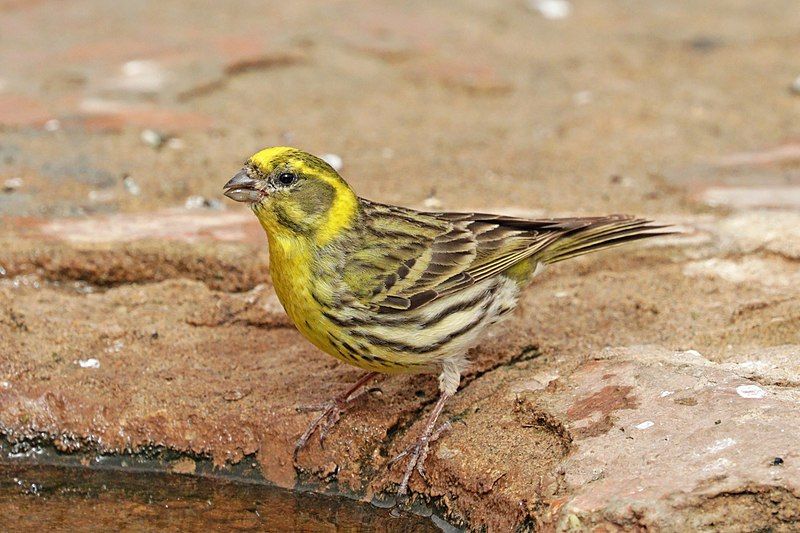
The European serin is the smallest species of the family of finches and is closely related to the Atlantic canary. It is a small bird, usually measuring around 11 cm long and weighing 10 and 15 grams.
Its plumage is typically a pale yellow, with a light brown line running down the back and a white belly.
The serin is usually found in open countryside, such as meadows and fields, and is quite common in many parts of Europe. The serin’s diet consists mainly of buds and seeds, which it collects from the ground or plants.
It will also occasionally eat small insects or caterpillars. The serin is a social bird, often seen in flocks of up to 30 individuals. It is an agile flyer that can move quickly between trees and bushes for food.
In the winter, the serin will often migrate to more temperate climates to find an adequate food supply. The European serin is a famous bird among birdwatchers and pet owners alike. Its vibrant colors and cheerful song make it an attractive addition to any garden.
It is also famous for aviaries and bird shows due to its hardy nature and ability to adapt to captivity.
| Kingdom | Animalia |
| Phylum | Chordata |
| Class | Aves |
| Order | Passeriformes |
| Family | Fringillidae |
| Genus | Serinus |
| Species | S. serinus |
3. Common Firecrest
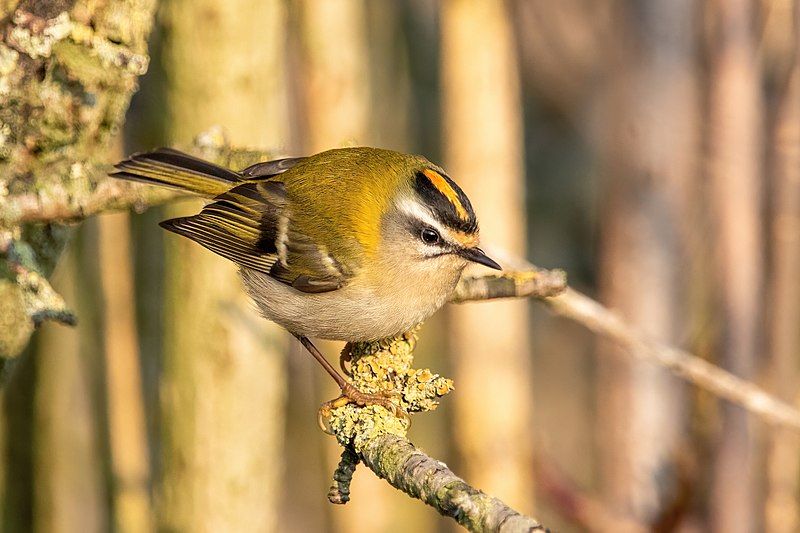
The Common Firecrest is a tiny bird belonging to the Kinglet family. It is widely distributed in temperate regions of Europe and Northwestern Africa.
Interestingly, it shows partial migration behavior; birds from Central Europe migrate to the south and west of their breeding range during winter. This species is best known for its vibrant golden-orange crest, named Firecrest.
Its plumage is mainly grey and olive-green, with a white chin, throat, and black eye patch. It is active and agile, flitting around trees and shrubs for food.
The Common Firecrest feeds on insects, spiders, and small invertebrates, supplementing its diet with fruits and berries during autumn and winter. It builds its nest in the dense foliage of trees and bushes, lining it with moss and feathers.
The female lays up to eight eggs, which are incubated for around two weeks before the chicks hatch.
| Kingdom | Animalia |
| Phylum | Chordata |
| Class | Aves |
| Order | Passeriformes |
| Family | Regulidae |
| Genus | Regulus |
| Species | R. ignicapilla |
4. Spotless Starling
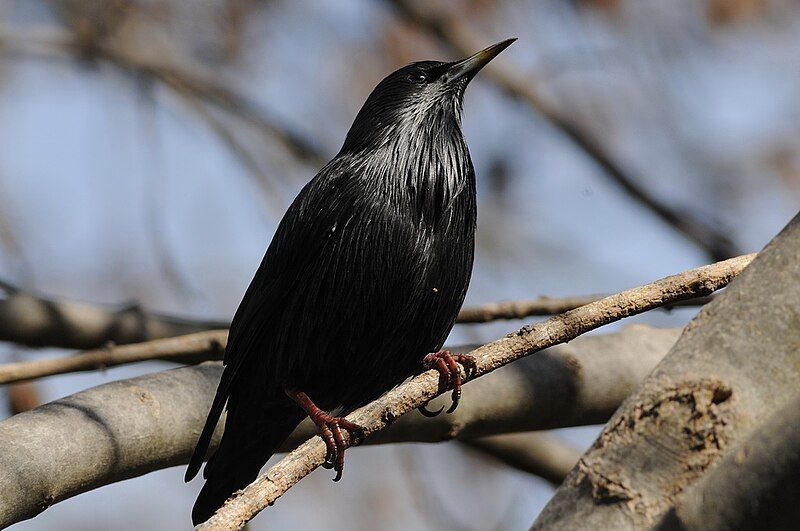
The spotless starling is a species of passerine bird that belongs to the Sturnidae family, which includes the common starling. It is native to the Iberian Peninsula, Northwest Africa, southern France, and Sicily, Corsica, and Sardinia islands.
Unlike its relative, the common starling, the spotless starling is non-migratory mainly, meaning that it does not migrate to other parts of the world but remains within the same region for most of the year.
This species is also much more restricted in range than its relative, the common starling, which can be found in many more parts of the world. This species is found in open habitats such as fields, pastures, orchards, gardens, woodland edges, and scrubby areas.
It feeds mainly on insects and other invertebrates, such as beetle larvae, caterpillars, earthworms, millipedes, and snails. It also occasionally eats small fruits and seeds.
The spotless starling is monogamous and builds a cup-shaped nest of grass and moss, usually in a tree or bush. The female lays 3-5 eggs, which are incubated for 12-13 days.
The spotless starling is a relatively small bird, measuring around 20 cm long and weighing around 40 grams. It has a glossy black bill, bright yellow eyes, and a mainly black head and body.
It is named for its lack of spots on its feathers, although it does have some white markings on its wings. Despite its restricted range, the spotless starling is a widespread species with a stable population.
| Kingdom | Animalia |
| Phylum | Chordata |
| Class | Aves |
| Order | Passeriformes |
| Family | Sturnidae |
| Genus | Sturnus |
| Species | S. unicolor |
5. Great Cormorant
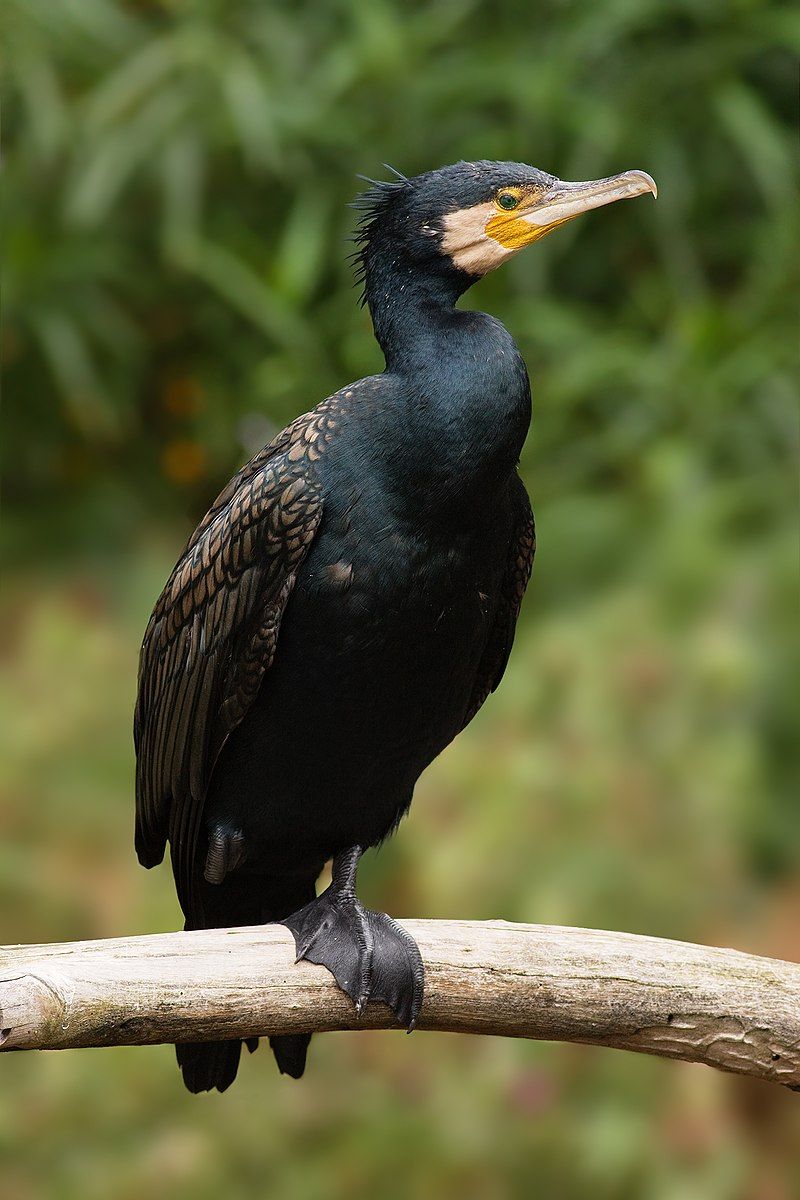
The great cormorant is a type of seabird found across the Northern Hemisphere, Australia, India, and New Zealand.
In New Zealand, it is commonly known as the black shag or kawau, while it is known as the great black cormorant across the Northern Hemisphere, the black cormorant in Australia, and the large cormorant in India.
It is a member of the cormorant family of seabirds and is highly widespread across these many different areas. The great cormorant is a large bird often seen along the shorelines of oceans and other bodies of water.
It has a long, slender body, and long, webbed feet allow it to dive beneath the water’s surface to catch its food. Its feathers are a dark, glossy black color that stands out against the water.
Its wingspan can reach up to five feet long, allowing it to soar quickly over the water’s surface. The great cormorant is an excellent swimmer and diver and has been known to dive as deep as 60 feet in search of food.
It is an opportunistic feeder, eating fish, crustaceans, and other aquatic creatures. It typically roosts in large colonies and is known to be very loud and vocal.
The great cormorant is an integral part of the marine environment and is a species that is highly valued and appreciated by many. Its presence is essential to help maintain a healthy aquatic ecosystem and significantly benefits humans and wildlife.
| Kingdom | Animalia |
| Phylum | Chordata |
| Class | Aves |
| Order | Suliformes |
| Family | Phalacrocoracidae |
| Genus | Phalacrocorax |
| Species | P. carbo |
6. Common Wood Pigeon
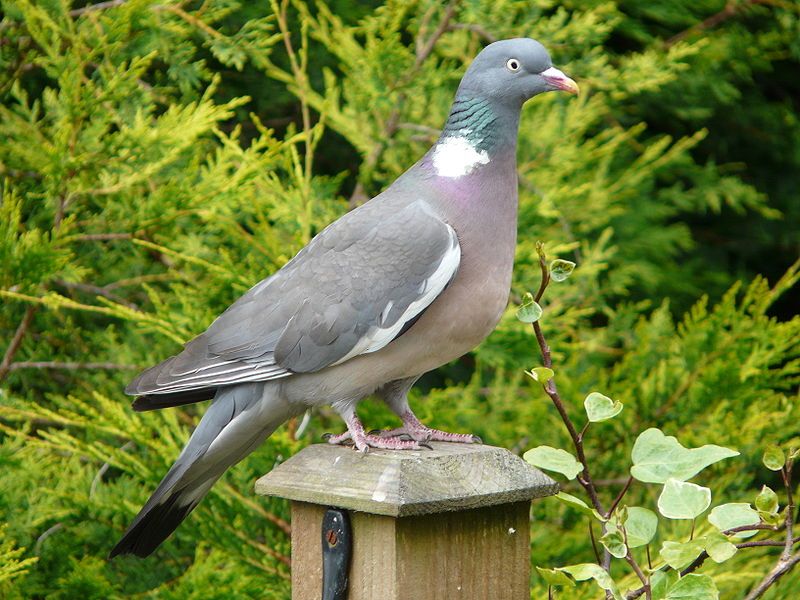
The standard wood pigeon is a large species of bird belonging to the dove and pigeon family. It is native to the western Palearctic region, which includes parts of Europe, North Africa, and the Middle East.
It is part of the genus Columba, which includes a variety of closely related species, such as the rock dove. Common wood pigeons are usually grey, with a white neck patch and two black bars on the wings.
They are primarily found in forests and woodlands, where they feed on grasses, seeds, and grains. They also come to parks and gardens to feed on bird feeders. Wood pigeons are very friendly and can often be seen in small flocks.
They are also very territorial and will defend their nesting sites from intruders.
| Kingdom | Animalia |
| Phylum | Chordata |
| Class | Aves |
| Order | Columbiformes |
| Family | Columbidae |
| Genus | Columba |
| Species | C. palumbus |
7. Black Redstart
The black redstart is a small passerine bird belonging to the genus Phoenicurus. It belongs to the Old World flycatcher family, distinct from the thrush family, in which it was previously classified.
It has a few different common names, such as Tithys redstart, blackstart, and black redtail, which are now obsolete due to its reclassification.
This bird is usually found in open woodlands, parks, and gardens and is known for its distinctive black and red plumage.
It is an active bird and can often be seen flitting around, searching for insects. The black redstart is a unique and exciting bird that is worth observing.
| Kingdom | Animalia |
| Phylum | Chordata |
| Class | Aves |
| Order | Passeriformes |
| Family | Muscicapidae |
| Genus | Phoenicurus |
| Species | P. ochruros |
8. Common Moorhen
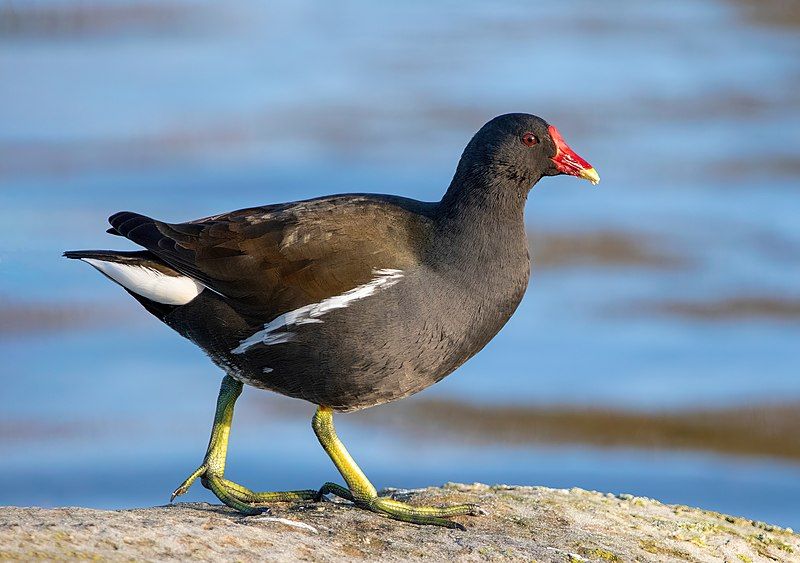
The common moorhen is a bird species belonging to the rail family. It is found in many parts of the Old World, including the Americas, Europe, Asia, and Africa. It is a water bird known as the waterhen or swamp chicken.
The common moorhen is usually found near freshwater wetlands, such as marshes, ponds, and canals. It prefers densely vegetated areas and will feed on aquatic plants, insects, and small rodents. It is an excellent swimmer and can also walk on floating vegetation.
The common moorhen is a relatively large bird with a length of up to 13 inches and a wingspan of up to 24 inches. It has a gray-brown body, a white belly, and a distinctive yellow bill. The wings and tail are black with white edges, and the legs and toes are yellow.
It is a vocal bird with various calls, including a loud, repetitive clucking sound. The common moorhen is a social bird and usually lives in groups of up to 20 individuals. It is a strong flier and will often travel between wetlands for food.
During the breeding season, which usually occurs in the spring, the male bird will perform a courtship dance to attract a female. The female will then build a nest on the ground or in a shallow depression and lay up to eight eggs, which will be incubated for 18 days.
The chicks will then fledge after an additional 18 days. The common moorhen is an essential species in many wetlands and a famous game bird in some areas. It is listed as Least Concern on the IUCN Red List, as its population numbers are stable.
| Kingdom | Animalia |
| Phylum | Chordata |
| Class | Aves |
| Order | Gruiformes |
| Family | Rallidae |
| Genus | Gallinula |
| Species | G. chloropus |
9. Sardinian Warbler
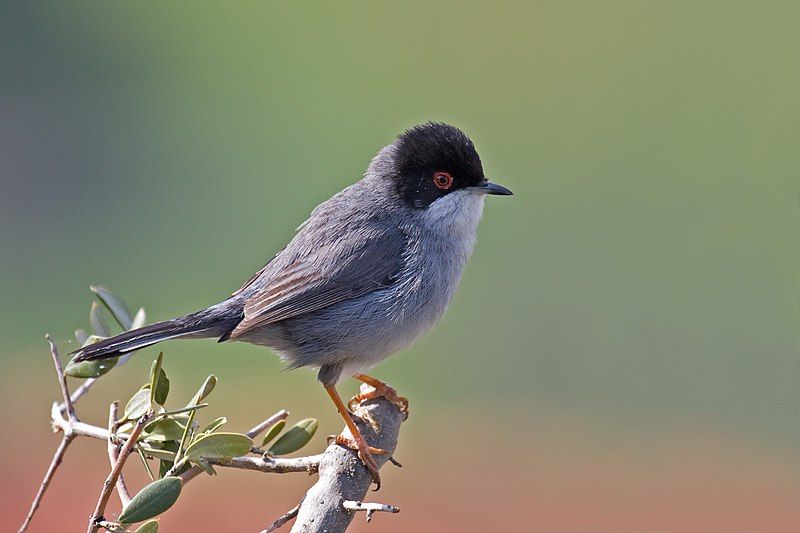
The Sardinian warbler (Curruca melanocephala) is a widespread small passerine bird found in the Mediterranean region. It has distinct male and female plumages, with the adult male having a grey back, whitish underparts, black head, white throat, and red eyes.
The female is similar to the male but has a yellowish-brown head and a grey back. The Sardinian warbler is typical, meaning it has a medium-long bill, rounded wings, and a short, slightly forked tail.
It feeds mainly on insects, which it catches by gleaning or hawking, and it can also be seen feeding on berries and seeds. It breeds in most of its range between May and July and nests in shrubs, bushes, and trees.
The Sardinian warbler is an adaptable species found in various habitats, including woodlands, scrub, grasslands, wetlands, hedgerows, and gardens.
| Kingdom | Animalia |
| Phylum | Chordata |
| Class | Aves |
| Order | Passeriformes |
| Family | Sylviidae |
| Genus | Curruca |
| Species | C. melanocephala |
10. Stock Dove
The stock dove, also known as the stock pigeon, is a species of bird belonging to the family Columbidae. This family is comprised of both doves and pigeons. The stock dove is a widespread species throughout the western Palearctic region.
This area encompasses Europe, the northwest coast of Africa, and parts of the Middle East. The stock dove is a medium-sized bird that typically measures between 28 and 33 cm long, with a wingspan of 48 to 54 cm.
Its plumage is primarily greyish-brown on its back and wings, with a pale chest and neck. Its tail is dark grey with a white tip.
The stock dove is a very vocal species with a distinctive low-pitched call often heard in the early morning and evening. The stock dove primarily feeds on seeds, grains, and fruits. It will also consume insects and other small invertebrates.
It lives in open woodlands, farmland, and other habitats with plenty of trees and shrubs. It usually makes its nest in tree hollows, cliffs, or buildings. The stock dove is considered to be a common species, and its population is not thought to be in decline.
However, it is still hunted in some countries, including France and the United Kingdom. It is also sometimes kept as a pet, but this is not recommended as it may spread diseases.
| Kingdom | Animalia |
| Phylum | Chordata |
| Class | Aves |
| Order | Columbiformes |
| Family | Columbidae |
| Genus | Columba |
| Species | C. oenas |
11. Pallid Swift
The pallid swift is a species of swift, a small bird characterized by its short legs. This species of swift belongs to the genus Apus, which comes from the Latin word for “swift.” The species name, pallidum, is also Latin and means “pale.”
This species of swift is distinguished by its pale coloring. Swifts are known for short legs, used only for clinging to vertical surfaces, such as tree trunks or cliff faces.
They cannot land on the ground voluntarily, as they cannot take off again. Instead, they must launch off a vertical surface to take flight. The pallid swift is an aerial species, meaning it spends most of its life in the air.
It can fly at high speeds and is often seen in large flocks, gliding effortlessly through the air. This species of swift is found in many parts of the world, including the Americas, Europe, and Asia.
It prefers open habitats such as grasslands, marshes, and meadows, where it can easily find food and shelter. The pallid swift is an important species, as it plays an essential role in the ecosystem.
It feeds on various flying insects, and its presence helps keep insect populations in check. It also serves as an essential food source for many other animals, such as hawks and predatory birds.
| Kingdom | Animalia |
| Phylum | Chordata |
| Class | Aves |
| Clade | Strisores |
| Order | Apodiformes |
| Family | Apodidae |
| Genus | Apus |
| Species | A. pallidus |
12. Eurasian Blackcap
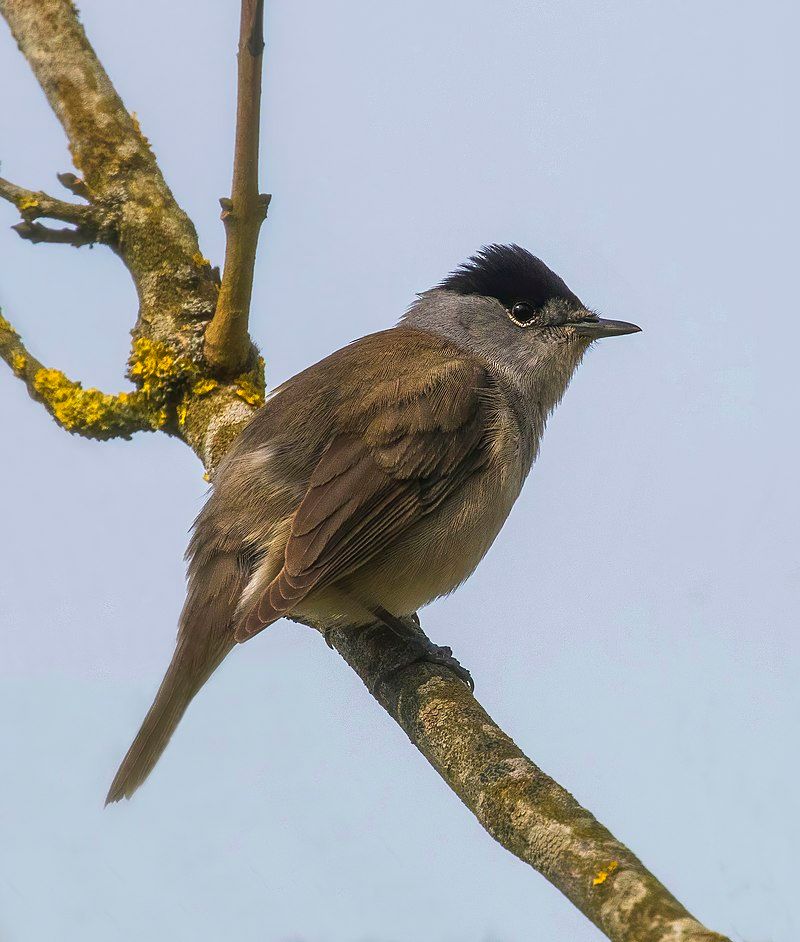
The Eurasian blackcap is a species of warbler found in many areas worldwide. It is a small bird, typically olive-grey with pale, grey underparts. This species is known for its distinctive black cap, which gives it its name.
The Eurasian blackcap is divided into five subspecies based on slight variations in physical characteristics. These variations are so minor that it can be difficult to tell them apart. The most common subspecies is the nominate form, found in much of Europe.
It is also found in North Africa, the Middle East, and Central Asia. Other subspecies, such as Northwest Africa, Southeast Asia, and the western Balkans, inhabit more specific areas.
The Eurasian blackcap is a reasonably common bird in rural and urban areas. They prefer open areas such as woodlands, hedgerows, and gardens. They feed on insects, larvae, and berries, making them a welcome sight in gardens as they help to control pests.
In many areas, the Eurasian blackcap is a migratory species. They migrate south for the winter and can be seen in large flocks during their migration. They often flock with other warbler species, such as the common whitethroat.
The Eurasian blackcap is a widespread warbler species due to its beautiful appearance and helpful habits. It is common in many areas, and its five subspecies are widely distributed.
| Kingdom | Animalia |
| Phylum | Chordata |
| Class | Aves |
| Order | Passeriformes |
| Family | Sylviidae |
| Genus | Sylvia |
| Species | S. atricapilla |
13. Spanish Imperial Eagle
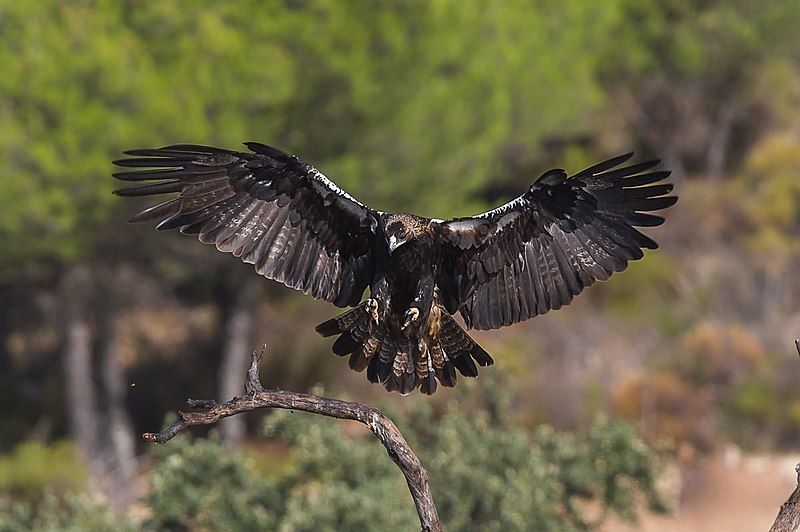
The Spanish imperial eagle is a species native to the Iberian Peninsula. It is also known by other names, such as the Iberian imperial eagle, the Spanish eagle, or Adalbert’s eagle. This bird was given its scientific name to commemorate Prince Adalbert of Bavaria.
The Spanish imperial eagle is an impressive bird species with a wingspan reaching 6.5 feet. It is a large bird with a blackish-brown body, a white head, and a yellow bill. It has a distinctive crest of feathers on its head.
The eagle’s legs and feet are yellow, and its wings are generally brown with white patches. This species is a top predator, with a diet consisting primarily of small mammals, birds, and fish. It can also feed on carrion and is known to scavenge for food.
The Spanish imperial eagle is found mainly in mountainous regions, using its powerful talons to catch its prey. Due to habitat loss and illegal hunting, the Spanish imperial eagle is an endangered species.
The species was declared extinct in 1972 but has since seen a resurgence in population numbers due to conservation efforts. It is now estimated that around 2000 Spanish imperial eagles are in the wild.
Overall, the Spanish imperial eagle is an impressive bird species with a unique binomial name commemorating Prince Adalbert of Bavaria. It is a top predator, powerful and majestic, and unfortunately, it is also an endangered species due to human activities.
Conservation efforts are ongoing to protect this species and help it thrive in its native habitat.
| Kingdom | Animalia |
| Phylum | Chordata |
| Class | Aves |
| Order | Accipitriformes |
| Family | Accipitridae |
| Genus | Aquila |
| Species | A. adalberti |
14. Egyptian Goose
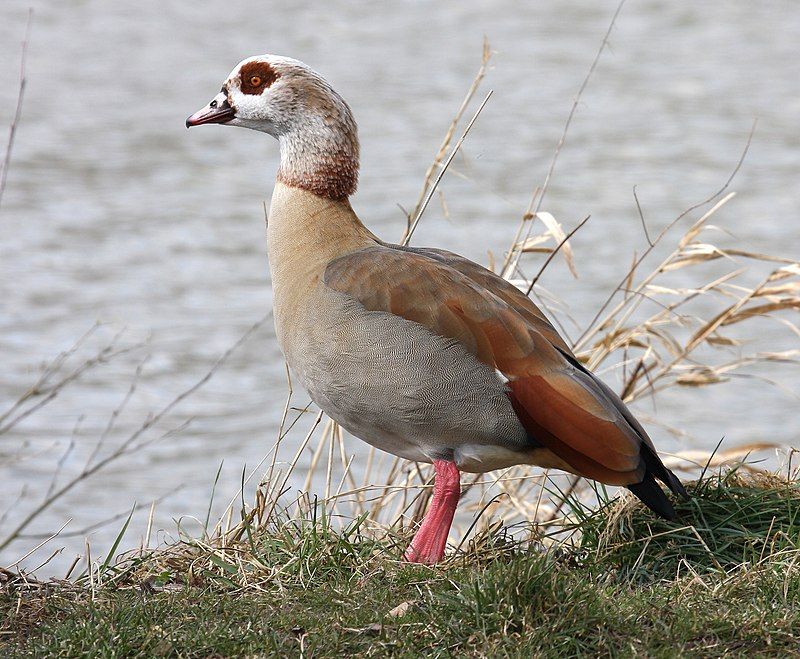
The Egyptian Goose is a species of duck that is native to Africa. It is a member of the Anatidae family, which includes ducks, geese, and swans.
Due to its attractive appearance, it has been introduced to regions outside of its natural range, including Europe and the United States.
This species has become popular mainly as an ornamental bird in parks and gardens for its beauty. The Egyptian Goose is a medium-sized waterfowl, typically measuring between 50 and 70 cm in length. It has a long, narrow neck and a short, rounded body.
Its head is a light brown, while its body is a mottled mix of gray, brown, and white. Its wings are a darker gray, with black tips and white primaries.
Its legs and feet are orange-red. In its natural habitat, the Egyptian Goose can be found near large bodies of water such as rivers and lakes. It feeds mainly on aquatic vegetation but will also eat grains and insects.
It nests in dense vegetation, typically near the water’s edge. The species is highly friendly and can often be found in large flocks.
It is known for its loud honking call, which can be heard at distances of up to three kilometers. The Egyptian Goose is listed as Least Concern by the IUCN, meaning that its population is stable and does not face any significant threats.
However, it is still vulnerable to habitat destruction and hunting, and its numbers decrease in certain parts of its range.
| Kingdom | Animalia |
| Phylum | Chordata |
| Class | Aves |
| Order | Anseriformes |
| Family | Anatidae |
| Genus | Alopochen |
| Species | A. aegyptiaca |
15. Woodchat Shrike
The woodchat shrike is a bird that belongs to the shrike family, Laniidae. It is easily identifiable by its distinctive red-brown crown and nape.
As an insectivore, its diet primarily consists of insects, and it prefers open wooded areas with scattered trees, such as orchards, where there is often bare or sandy ground.
This bird has a variety of habitats, ranging from woodlands to coastal dunes, and it is found throughout Europe, North Africa, and the Middle East. It mainly hunts for its food on the ground and is known to have a bold and inquisitive nature, often approaching humans.
It is an important predator in its habitat, playing an essential role in controlling insect populations.
| Kingdom | Animalia |
| Phylum | Chordata |
| Class | Aves |
| Order | Passeriformes |
| Family | Laniidae |
| Genus | Lanius |
| Species | L. senator |
Conclusion
The birds of Madrid are a diverse and vibrant part of the city’s natural beauty. Whether watching a flock of storks in the sky or admiring the colorful plumage of a parakeet, the city’s birds give Madrid an undeniably unique and lively atmosphere.
Through conservation measures, Madrid has ensured that its avian population can thrive and continue to bring joy to its citizens and visitors alike.